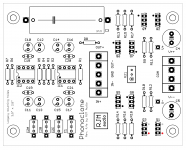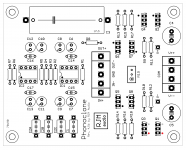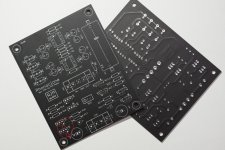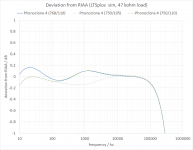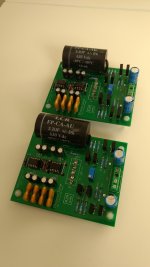2Vac is normally seen as the maximum voltage through a Buffer stage and as the maximum voltage into a Power Amp. Many Amplifiers will not accept any more than 700mVac, without voltage clipping.....................
The DL103 has a 0.3mv output which means that setting the phonoclone at 75dB gain I should get almost 2Vrms output which is more than enough, .................
The 0.3mVac is the cartridge specification for an average groove modulation. Have they used 5cm/s as the reference?
Maximum could be anywhere from 25cm/s to 40cm/s which is 14dB to 18dB above 5cm/s
I think you should look at Dimkasta's advice and massively lower your RIAA gain.
eg.
+60dB RIAA gain stage with an input of 0.3mVac @ 5cm/s +14dB when max is @ 25cm/s gives an output of 300mVac*5 = 1.5Vac
Most amplifiers will overload at this level and require vol pot attenuation of ~-6dB to just avoid clipping.
Most of the time you will probably be applying -26dB of attenuation for normal listening levels.
Last edited:
Little to add here, dimkasta and AndrewT already covered it: you want to set the phonoclone gain to 60 dB, much like any other MC phono stage. The downstream gain distribution is up to you, but it revolves around the amplifier. If the amp sensitivity is high enough, you won't need a preamplifier with voltage gain just a buffer will suffice, otherwise you will.
I use the DL103 with a phonoclone set at 60 dB, a line Sapphire stage at 12 dB, and an amp which is about 31 dB, with 82 dB/W/m speakers. It's too much for my small room, I need to drop 6 dB from the line stage. While I could adjust the phonoclone, it would be a poor solution since if I changed sources or changed phono stages even the problem would return.
Everyone says that adding an active line stage improves base response and general impression of solidity and this has been my experience also. I don't know if anyone has conclusively shown the cause of this, but there are anyway various reasons for why power amplifiers are best driven by a low impedance signal.
I use the DL103 with a phonoclone set at 60 dB, a line Sapphire stage at 12 dB, and an amp which is about 31 dB, with 82 dB/W/m speakers. It's too much for my small room, I need to drop 6 dB from the line stage. While I could adjust the phonoclone, it would be a poor solution since if I changed sources or changed phono stages even the problem would return.
Everyone says that adding an active line stage improves base response and general impression of solidity and this has been my experience also. I don't know if anyone has conclusively shown the cause of this, but there are anyway various reasons for why power amplifiers are best driven by a low impedance signal.
On phonoclone 4.4s and 4.5b board the white dots of Q1 and Q3 are incorrectly placed next to pin 3 instead of pin 1. BOM and board images have been edited to show the error and correct position.
Attachments
I put them there to indicate pin 1, emitter, of the transistors. They also indicate, indirectly, the front face of the package. With the default silkscreen TO-126 package it's hard to tell which is the back and which is the front, people have tended to solder in the transistor 180 deg. rotated by mistake.
hi Richard,
I'm currently putting together the 4.4s phonoclone. For the RIAA resistors R5 and R6. Are the values critical ? From your website, R6 = 750k, however, in BOM and schematic, R6 = 768k. Would you be kindly let me know which values should I use for R6? I want to match them as close as possible to your simulation.
Thanks,
Tom
I'm currently putting together the 4.4s phonoclone. For the RIAA resistors R5 and R6. Are the values critical ? From your website, R6 = 750k, however, in BOM and schematic, R6 = 768k. Would you be kindly let me know which values should I use for R6? I want to match them as close as possible to your simulation.
Thanks,
Tom
Hi,
Short answer: use the BOM values of 768k and 110k.
Longer answer:
So what's going on here is the web page values are tabled as 5% tolerance values, hence 750k and 110k. 2k2 ohm resistors etc. That's just a "ok you want to build a phonoclone here you go" list of values for the circuit.
The BOM files are for the boards specifically, rather than the circuit generally, listing specific parts. They are 1% tolerance resistors, so the values are chosen from the 1% list. There are two options for R5 and R6: 110k/768k or 105k/750k. Both are acceptable but I chose 110k/768k for the BOM.
Not that 750/110 is bad or anything. They are all close enough.
Short answer: use the BOM values of 768k and 110k.
Longer answer:
So what's going on here is the web page values are tabled as 5% tolerance values, hence 750k and 110k. 2k2 ohm resistors etc. That's just a "ok you want to build a phonoclone here you go" list of values for the circuit.
The BOM files are for the boards specifically, rather than the circuit generally, listing specific parts. They are 1% tolerance resistors, so the values are chosen from the 1% list. There are two options for R5 and R6: 110k/768k or 105k/750k. Both are acceptable but I chose 110k/768k for the BOM.
Not that 750/110 is bad or anything. They are all close enough.
Attachments
Thank you so much for a very clear reply and explanation, Richard! Superb!
Best,
Tom
Best,
Tom
Hi,
Short answer: use the BOM values of 768k and 110k.
Longer answer:
So what's going on here is the web page values are tabled as 5% tolerance values, hence 750k and 110k. 2k2 ohm resistors etc. That's just a "ok you want to build a phonoclone here you go" list of values for the circuit.
The BOM files are for the boards specifically, rather than the circuit generally, listing specific parts. They are 1% tolerance resistors, so the values are chosen from the 1% list. There are two options for R5 and R6: 110k/768k or 105k/750k. Both are acceptable but I chose 110k/768k for the BOM.
Not that 750/110 is bad or anything. They are all close enough.
Hi, got round to completing the 4.4S last week.
I've built the boards into a similar case to the one I use for my 3.5h, using the same values for R2 to try and keep the volume levels the same or similar!
I have to confess that for me reworking the wiring etc is a pain - because I don't think I'm any good at it , but somehow I eventually got the same or slightly lower hiss levels.
, but somehow I eventually got the same or slightly lower hiss levels.
All sorts of factors may be at play but general feeling is that there is a little more but tighter bass, maybe a bit more than I'm used to. Nice natural sound to stringed instuments and lots of clean defined music but perhaps to me not as balanced overall as the 3.5h. Early days.
I need to simply listen to a lot of music without swaping too much
I've built the boards into a similar case to the one I use for my 3.5h, using the same values for R2 to try and keep the volume levels the same or similar!
I have to confess that for me reworking the wiring etc is a pain - because I don't think I'm any good at it
All sorts of factors may be at play but general feeling is that there is a little more but tighter bass, maybe a bit more than I'm used to. Nice natural sound to stringed instuments and lots of clean defined music but perhaps to me not as balanced overall as the 3.5h. Early days.
I need to simply listen to a lot of music without swaping too much
Attachments
Interesting. Thanks for the report.
Bass is typically a bit lumpen for the first few days powered up. If it ends up a bit more pronounced than on the X-reg versions (and I tend to agree with you on that) from my point of view it rectifies a deficiency of the earlier design, which always seemed a little bit low contrast to me.
Bass is typically a bit lumpen for the first few days powered up. If it ends up a bit more pronounced than on the X-reg versions (and I tend to agree with you on that) from my point of view it rectifies a deficiency of the earlier design, which always seemed a little bit low contrast to me.
hi all,
Time for some pics. It takes me a while to make this post. Busy with listening to my new toys; Opamp rolling and comparing with some of the toys that I had in stock.
After a spending few days listening to all types of music genres with Phonoclone and swapping out a few capacitors and opamps, I finally came to conclusion OPA27 is the best choice of opamps on this design as originally suggested by Richard in combination with Russian caps in RIAA and output coupling The music flows very naturally. Very airy and open on the top end and nice tight bass in the bottom end. Not too much boomy bass but just enough.
The music flows very naturally. Very airy and open on the top end and nice tight bass in the bottom end. Not too much boomy bass but just enough.
I compared Phonoclone to ADA797 phonostage and Pearl 2 phono from Pass design on my DIY setup: Rega P5 turntable + Denon DL103r + Alelph J DIY class A power amp. I must say Phonoclone is surpassing ADA797 and somewhat comparable to Pearl 2. Pearl 2 has some up sides over Phonoclone but Phonoclone also comes very closed. It's a good keeper for me.
Thank you again for the great design and your contribution to DIY audio community Richard. Thank you so much for your generosity sending me the last pair of 4.4s board and all of your support for me to finish it the project.
Best regards,
Tom
P.s.: 2nd photo, I have ADA797 phono stage plugged in the main system in the process of comparing with phonoclone and having fun at the same time
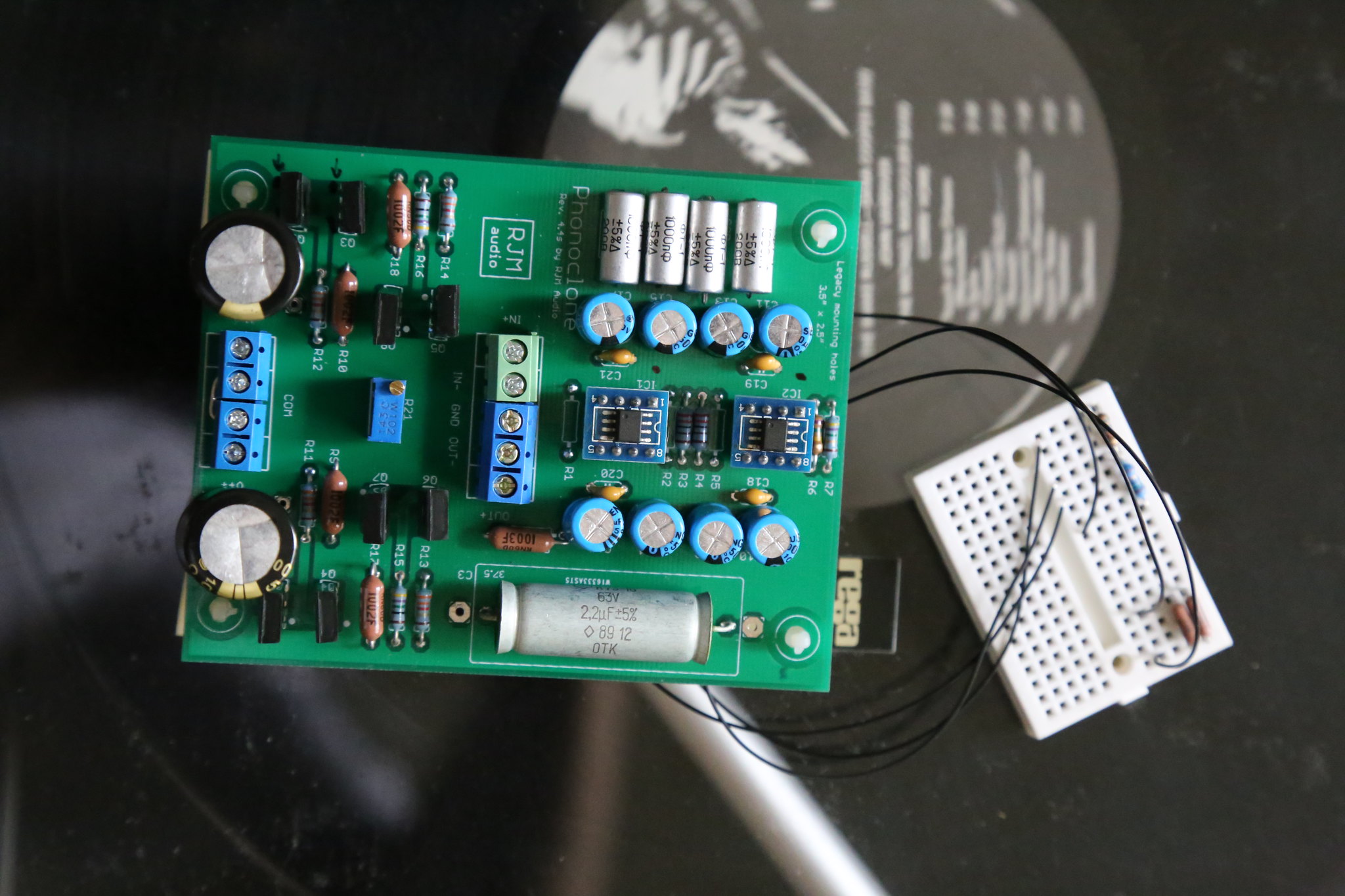
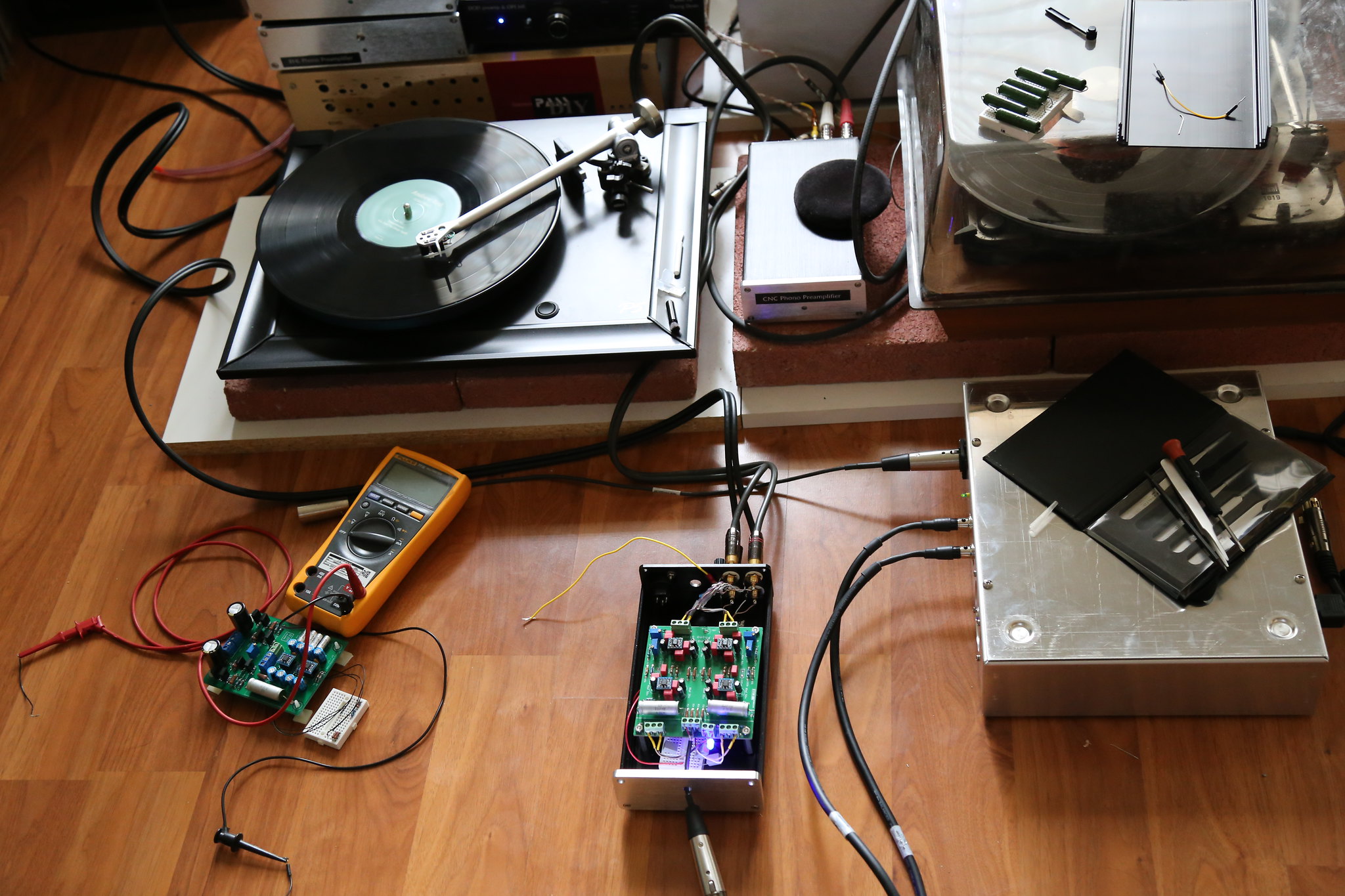
Time for some pics. It takes me a while to make this post. Busy with listening to my new toys; Opamp rolling and comparing with some of the toys that I had in stock.
After a spending few days listening to all types of music genres with Phonoclone and swapping out a few capacitors and opamps, I finally came to conclusion OPA27 is the best choice of opamps on this design as originally suggested by Richard in combination with Russian caps in RIAA and output coupling
I compared Phonoclone to ADA797 phonostage and Pearl 2 phono from Pass design on my DIY setup: Rega P5 turntable + Denon DL103r + Alelph J DIY class A power amp. I must say Phonoclone is surpassing ADA797 and somewhat comparable to Pearl 2. Pearl 2 has some up sides over Phonoclone but Phonoclone also comes very closed. It's a good keeper for me.
Thank you again for the great design and your contribution to DIY audio community Richard. Thank you so much for your generosity sending me the last pair of 4.4s board and all of your support for me to finish it the project.
Best regards,
Tom
P.s.: 2nd photo, I have ADA797 phono stage plugged in the main system in the process of comparing with phonoclone and having fun at the same time


Could you please confirm which phono stage you built? I have to guess from your location and my recent order list that you refer to the VSPS200 and the kit parts.
This is a comparatively recent iteration, so there is not so much collective experience in the advice pool unfortunately.
I suggest the following:
1. wait 100h powered up before making any definitive judgement
2. replace NE5534A with OPA134 or perhaps even OPA27.
3. replace C3 with good audio type capacitor of 1 uF or larger.
4. consider the power supply - I don't know what you used but a large VA rated transformer can improve dynamics, and electrostatic screen / RFI filtering can sometimes improve resolution.
hope that helps
/R
This is a comparatively recent iteration, so there is not so much collective experience in the advice pool unfortunately.
I suggest the following:
1. wait 100h powered up before making any definitive judgement
2. replace NE5534A with OPA134 or perhaps even OPA27.
3. replace C3 with good audio type capacitor of 1 uF or larger.
4. consider the power supply - I don't know what you used but a large VA rated transformer can improve dynamics, and electrostatic screen / RFI filtering can sometimes improve resolution.
hope that helps
/R
A friend and I downloaded the layout from you site, the name on the circuit board says RJM Audio VSPS 300m. We have made our own PCB´s, we did not buy yours, maybe later, for a final version with the best parts.
We both made a compete riaa, and with almost the same parts, and they sound completely alike. We use it with a Ortofon T20 transformer infront of it. When I use the transformer with an old NAD 1240 pre, I have the dynamics and resolution in the midrange I need. I think the transformer is good enough. We use 47Kohm inputimpedance in the Riaa.
I have tried both op134 and NE5534 op amp, no sound difference. C3 is an ok, audio capacitor, Jantzen cross cap, could be better, but not a bad capacitor.
It has not played 100h yet, I am also considering powersupply it with batteries to try and leave the PSU out of it. The PSU is in the same smaller box, and that gives some hum if I turn up the level, but no problem at normal listening levels.
I have 33Kohm for R7, the parallel resistor on the output, I guess it should not be to big a load, when it is connected with the 100Kohm input impedance of my amp. The riaa is measured with an anti-riaa correction filter, it is measures beautifully flat.
We both made a compete riaa, and with almost the same parts, and they sound completely alike. We use it with a Ortofon T20 transformer infront of it. When I use the transformer with an old NAD 1240 pre, I have the dynamics and resolution in the midrange I need. I think the transformer is good enough. We use 47Kohm inputimpedance in the Riaa.
I have tried both op134 and NE5534 op amp, no sound difference. C3 is an ok, audio capacitor, Jantzen cross cap, could be better, but not a bad capacitor.
It has not played 100h yet, I am also considering powersupply it with batteries to try and leave the PSU out of it. The PSU is in the same smaller box, and that gives some hum if I turn up the level, but no problem at normal listening levels.
I have 33Kohm for R7, the parallel resistor on the output, I guess it should not be to big a load, when it is connected with the 100Kohm input impedance of my amp. The riaa is measured with an anti-riaa correction filter, it is measures beautifully flat.
Sounds like you have all the usual things covered already. The VSPS300 has the X-Reg. There is not normally any hum, but if you have the power transformer in a shared enclosure that can easily cause pickup. You may want to double check voltages to make sure the op amps are seeing about 10 V. If it was me I'd also measure the output noise spectrum. If there is hum with the volume turned up then that means there is a fair amount of low level background noise even at regular volume, and even though you can't hear it per se. this will negatively impact resolution and microdynamics. It's surprising actually, how important it is to have a hum/ripple-free background noise.
I've never felt the VSPS worked especially well with step-up transformers. That's just a hunch, no particular reason to think it would perform badly though. Maybe check how it sounds with a MM cart with no transformer, just for reference.
I've never felt the VSPS worked especially well with step-up transformers. That's just a hunch, no particular reason to think it would perform badly though. Maybe check how it sounds with a MM cart with no transformer, just for reference.
The most recent BOM values are
R9, R10 221R
R11-14 33.2k
R15-18 2.21k
R19, R20 100k
If the V++ is only 15 V I suggest increasing R11-14 to 39k approx. The output V+ is expected to be about 8 V.
The X-Reg has very high dropout, if you want 12 V on the op amp you'll need about 18 V V++.
see attached worksheet
R9, R10 221R
R11-14 33.2k
R15-18 2.21k
R19, R20 100k
If the V++ is only 15 V I suggest increasing R11-14 to 39k approx. The output V+ is expected to be about 8 V.
The X-Reg has very high dropout, if you want 12 V on the op amp you'll need about 18 V V++.
see attached worksheet
Attachments
- Home
- Source & Line
- Analogue Source
- The Phonoclone and VSPS PCB Help Desk
